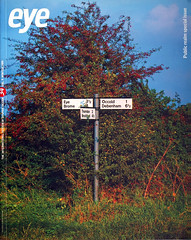Winter 1999
Virtual city: sidebar 2
A postmodern state?
(From ‘A virtual city in a global square’)
A referendum on whether or not Australia should become a republic took place on 6 November 1999, resulting in a majority vote (approximately 55 per cent) in favour of retaining the monarchy. This event provoked the question: ‘What does it mean to be Australian?’ Through such processes of self-realisation Australia has the potential to become the first postmodern state, comfortable in the process of continuous redefinition. This has profound implications on its graphic identity and the flag, the nation’s ‘branding’. Why have a flag with symbols that cannot encapsulate such a diverse people? In addition to its indigenous Aboriginal people, Australia is a land of recent and continuous immigration, and it can be perceived as one of the few genuine realisations of multiculturalism in the world.
Its contemporary energy stems from the confidence of its second- and third-generation immigrants who still have emotional, intellectual and social connections to the lands of their forebears. This gives Australia its internal richness and external context. In the past Australia copied (badly) from European and American models. The globalisation of telecommunications, production and distribution means that a vital and dynamic Australian voice that combines European, American and Asian models is emerging.
The Federation is the political entity that binds Australia’s seven states together. Lab Architecture Studio decided that Federation Square would be a contemporary site and that its philosophical core was ‘the continuous process of negotiation’. This is what it perceived as common to both the local society and the outside world. Its self-initiated brief was to construct a site where every aspect referred to this condition.
My brief was to interrogate the architectural proposal and to ensure that this informed every aspect of my commission: the signage. It soon became clear, however, that this meant that I had to understand and engage with not only the issues and conditions of communication, but also the form, content and programming of all aspects of communication in all media, including the architecture itself.
I decided that all the attempts that I had seen or read about were not addressing the situation because they were being steered by the context and traditional ‘authority’ of the architect, therefore limiting the site’s economic and cultural potential. My response was to invert this model and to have the conditions and issues of the mediated world, especially the Web, contextualise the site. The physical site became contextualised by the virtual realm, and my work was to construct the interface between these two entities.
For the past few years the media have been keenly observing Australia, reporting on beautiful shorelines, azure sky and water, great food and, lastly, Australian design. This initially looked interesting but on closer inspection you realised that you had seen it before, six months earlier, in either Europe or America. But now the emphasis is gradually shifting: from the viewpoint of the mediated world, if there is any aspirational form of society in the 21st century then it is the multicultural. And with that viewpoint comes cultural and economic engagement.
If there is a common factor to culturally important cities across the world then it is the fact of an active street culture.
Atlanta, with Coca-Cola and Pepsi-Cola, has extraordinary financial clout but by five o’clock in the evening it becomes a ‘tumbleweed town’. In global terms, Reykjavik is more culturally significant despite its size.
Australia, and Melbourne in particular (next stop Antarctica), is (tectonically) adrift from the world. All the other main English-speaking cities are in different time zones: London, New York, Los Angeles are respectively nine, fourteen and seventeen hours behind. Your working day is disrupted if you are communicating with these countries by phone, fax and/or courier. Computers, the Web, e-commerce and email have radically changed this.
John Warwicker, Tomato, London and Melbourne
First published in Eye no. 34 vol. 9, Winter 1999, Public realm special issue.
Eye is the world’s most beautiful and collectable graphic design journal, published quarterly for professional designers, students and anyone interested in critical, informed writing about graphic design and visual culture. It is available from all good design bookshops and online at the Eye shop, where you can buy subscriptions, back issues and single copies of the latest issue.

